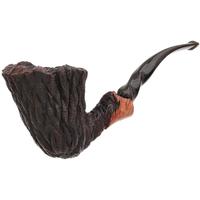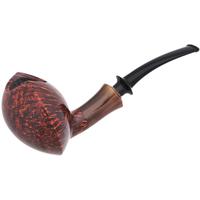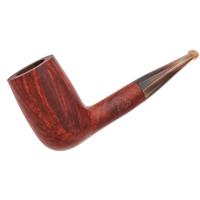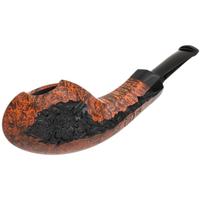This weekend I decided to open an old sealed tin of “Assens’ Finest Flake Cut”. There is no information to be found online regarding this blend, so I figured I’d document it here and ask that anyone with any knowledge of it please contribute. It would be nice to eventually get it added to the TR database.
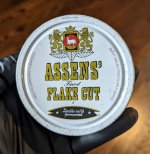
I am very interested in determining the age and the blend’s composition. There is only a single auction example where it was listed as “1980’s era”, however, this was simply speculation passed on from the original German seller. I think it is older based on its German Tobacco stamp. For example, 6,50 Deutsche Marks seems to jive more with the 1960’s-1970’s for a 50gr tin, based on comparisons to other German stamps I can find online. This older range also lines up with Assens’ own timeline of releasing new cuts from 1950-1970. At the very least, it is pre-STG (pre-1989).

This double-fermented “Curly Cake” is blended in Denmark, cut and packed in Germany. The well-preserved, petite tin measures a little over 3.25” x 1”. At first pry with my Czech tool I received a very welcome audible “pssss” as the vacuum of the tin was equalized. A great sign, but let’s twist and see what’s inside:
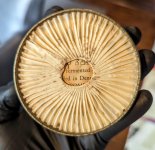
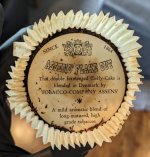
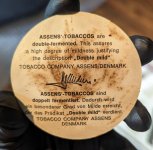
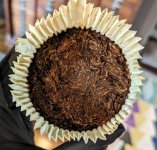
Oh my goodness - The tin note is the closest analog to freshly baked raisin bread I have ever smelled. Incredible! And thankfully it is not dry! Moisture level is comparable to something like BEF. Weight of the actual tobacco mass is 47 grams, so only a 3 gram loss in water weight over some 40-ish years. Nice.The entire surface sparkles in the light as it is coated with transparent, micro-crystalline sugars and/or other curing-related byproducts. The flakes are so compressed that it crumbles like a cake. It is definitely a “Curly Cake”.
So how does it smoke and what does it taste like? I’m terrible at this part, sorry, but some first impressions - In one word, it was, as the tin says, “Mild”, but sublimely so. Mildly sweet toasted graham cracker bread. There is also something different and intriguing here. It’s hard to explain, but I found myself chasing this earthy terroir-like note. I don’t know if that’s something related to different genetics of that time or just my imagination expecting something unique in such an old tobacco. Whatever it is, I find it alluring. A very slow sipping cadence is mandatory. Any puffing and things fall apart quickly. The room note is very pleasant. I love this tobacco.
I’ll give a more comprehensive review when I get to know it and understand it better. Again, I welcome any comments or additional info on this mysterious tin. It’s odd that there is virtually nothing to be found online. Thanks for reading!

I am very interested in determining the age and the blend’s composition. There is only a single auction example where it was listed as “1980’s era”, however, this was simply speculation passed on from the original German seller. I think it is older based on its German Tobacco stamp. For example, 6,50 Deutsche Marks seems to jive more with the 1960’s-1970’s for a 50gr tin, based on comparisons to other German stamps I can find online. This older range also lines up with Assens’ own timeline of releasing new cuts from 1950-1970. At the very least, it is pre-STG (pre-1989).

This double-fermented “Curly Cake” is blended in Denmark, cut and packed in Germany. The well-preserved, petite tin measures a little over 3.25” x 1”. At first pry with my Czech tool I received a very welcome audible “pssss” as the vacuum of the tin was equalized. A great sign, but let’s twist and see what’s inside:




Oh my goodness - The tin note is the closest analog to freshly baked raisin bread I have ever smelled. Incredible! And thankfully it is not dry! Moisture level is comparable to something like BEF. Weight of the actual tobacco mass is 47 grams, so only a 3 gram loss in water weight over some 40-ish years. Nice.The entire surface sparkles in the light as it is coated with transparent, micro-crystalline sugars and/or other curing-related byproducts. The flakes are so compressed that it crumbles like a cake. It is definitely a “Curly Cake”.
So how does it smoke and what does it taste like? I’m terrible at this part, sorry, but some first impressions - In one word, it was, as the tin says, “Mild”, but sublimely so. Mildly sweet toasted graham cracker bread. There is also something different and intriguing here. It’s hard to explain, but I found myself chasing this earthy terroir-like note. I don’t know if that’s something related to different genetics of that time or just my imagination expecting something unique in such an old tobacco. Whatever it is, I find it alluring. A very slow sipping cadence is mandatory. Any puffing and things fall apart quickly. The room note is very pleasant. I love this tobacco.
I’ll give a more comprehensive review when I get to know it and understand it better. Again, I welcome any comments or additional info on this mysterious tin. It’s odd that there is virtually nothing to be found online. Thanks for reading!



